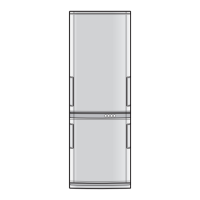STORING FOOD
Refrigeration reduces the rate of food spoilage.
Tomaximizetheshelflifeofperishablefoodproducts,
ensure that the food is the freshest possible quality.
The following is a general guide to help promote longer food
storage.
Fruit / Vegetables
Tominimizemoistureloss,fruitandvegetablesshouldbe
loosely enclosed in a plastic material e.g. wrap, bags (do
not seal) and place in the vegetable crisper.
Dairy Products & Eggs
• Mostdairyproductshaveausebydateontheouter
packaging which informs the recommended temperature
and shelf life of the product.
• EggsshouldbestoredintheEggholder.
Meats / Fish / Poultry
• Placeonaplateordishandcoverwithpaperorplastic
wrap.
• Forlargercutsofmeat,sh,orpoultry,placetotherearof
the shelves.
• Ensureallcookedfoodiswrappedsecurelyorplacedin
an airtight container.
NOTE
• Evenlyplacethefoodonthe
shelves to allow the cooling air to
circulateefciently.
• Hotfoodsshouldbecooled
before storing. Storing hot foods
increases the temperature in the
unit and increases the risk of food
spoilage.
• Donotblocktheoutletandinletof
the cool air circulating circuit with
foodsorcontainers;otherwisethe
foods will not be evenly cooled
throughout the refrigerator.
• Keepthedoorsecurelyclosed.
Do not place food directly in front of cold air
outlet.Thismayleadtothefoodfreezing.
For best freezing
• Qualityoffoodsshouldbefresh.
• Freezesmallquantitiesoffoodatatimetofreezethem
quickly.
• Foodshouldbeproperlysealed,sealedtightlyorcovered.
• Evenlyplacethefoodinthefreezer.
• Labelbagsorcontainerstokeepaninventoryoffreezing
food.
IN
OUT

